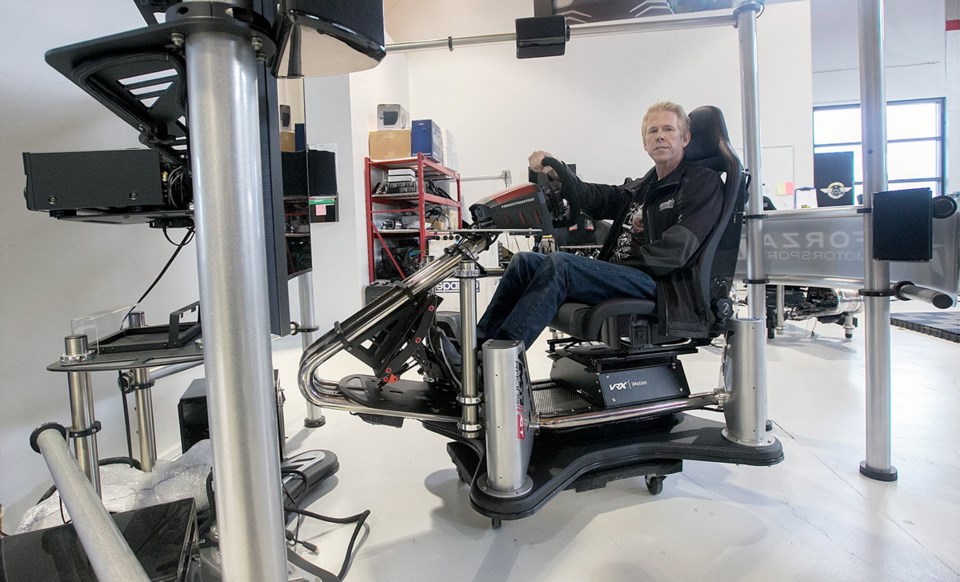When the drivers line up along the grid for the Daytona 500 on Feb. 18, there will be one Victoria man — and his inner seven year-old — likely to be more excited and nervous than anyone around the Daytona International Speedway.
Robert Stanners, chief executive of VRX Simulators, has waited 45 years to see his name on the hood of a NASCAR race car, and that day he’ll see it splashed across the 00 Camaro driven by Jeffrey Earnhardt.
It will be a big moment for Stanners, who fell in love with motorsport as a seven- year-old watching the cartoon Speed Racer on TV — VRX stands for Virtual Racer X and Racer X was his favourite Speed Racer character — but it will also splash the company name in front of a massive television audience.
But Stanners seems to look at the partnership with Earnhardt as more of an imperative, and the right thing to do for the sport, than a chance to catch some limelight.
“I could not sit back and allow there not to be an Earnhardt in [the Daytona 500],” said Stanners, a fan of the sport and of one of the most famous racing families in NASCAR. “There’s been an Earnhardt in that race for 39 years.”
Earnhardt lost his ride late last year, but StarCom Racing came up with a car and VRX stepped in as the sponsor.
Stanners, who has always wanted his own racing team, had already been working with the young Earnhardt — grandson to legend Dale Earnhardt Sr. and nephew to Dale Earnhardt Jr. VRX provided a training simulator for the young driver who wanted track-like training without the high cost and high risk of running laps in a million-dollar vehicle.
But to keep an Earnhardt in the Daytona 500 this year required a $7.5 million sponsorship commitment.
“I didn’t have that,” Stanners said with a laugh. But he did have big-name and big-money partners.
“I leveraged my partners. I made some moves and did some things and came up with it, and last week they announced Canada’s first ever fully sponsored NASCAR team,” he said.
Stanners wouldn’t elaborate on the moves, or the partners involved, but he does have a stable of big ones behind him.
VRX, which started with Stanners’ vision for racing and aircraft simulators for the home market and commercial use in 2003, has since worked with Microsoft, Intel, Ericsson, Toyota, Cineplex and T-Mobile, to name a few.
His work will get international exposure Feb. 18 at the Daytona 500. VRX will also ship demonstration products to the race site.
VRX got its first major boost in 2006 when it partnered with Microsoft’s Forza Motorsport to create a hardware environment to experience the video game.
“They wanted to build the best motorsports game ever, we partnered to create that user experience and that kick-started VRX,” Stanners said.
After selling one in 2003, they sold 30 to 35 in 2006. The units range from about $12,000 US to well over $400,000 US. “We rode the coattails of Microsoft,” he said.
VRX has started talks with NASCAR about improving the experience for spectators — think seats and headgear that let fans ride along with any driver — and about programs to draw in young people through getting them behind the wheel and into the virtual environment of the driver.
“We are about to do things that could change the experience side and kickstart new technology and ways to ignite the motorsports industry,” said Stanners.
He is also working with Cineplex to manufacture simulators for its Playdium and Rec Room concepts that are being installed across Canada.
But sitting in his office/manufacturing space in the industrial park in North Saanich, Stanners is adamant that all of the growth and expansion (he expects to double his staffing to 34 from 17 and require new space within the year) will have broader applications in education, safety and mobility.
He said VRX is a means to an end and he hopes it continues to put him in position to meet and partner with some of the heaviest hitters in the world, the ones who can make huge impacts.
An admitted idealist, Stanners wants to push people to use technology to keep improving the world.
And he promises the next two years will lead up to a big event “that will shake the world” when he announces VRX World.
“We are planning, building and designing VRX World now,” he said, noting they will make the announcement of what that entails at the start of 2020.
His excitement is noticeable as he holds court and you can still see the inner seven-year-old who fell in love with things that go fast. “I’m in a dream, and it really just got started,” he said.



